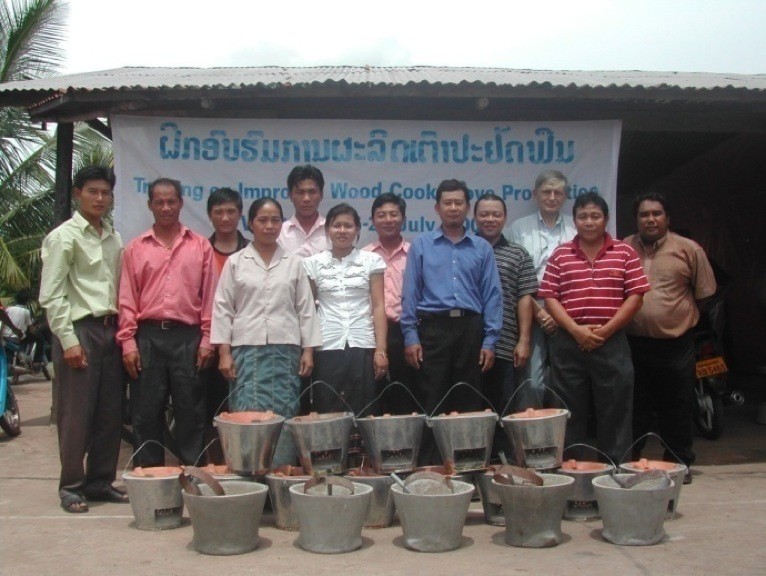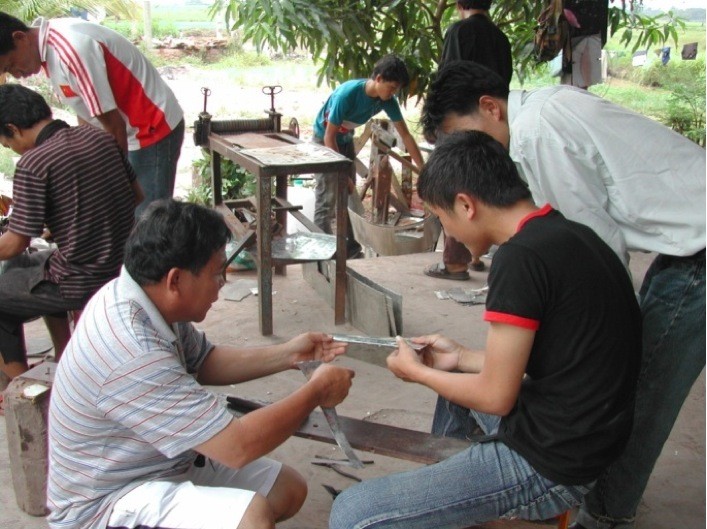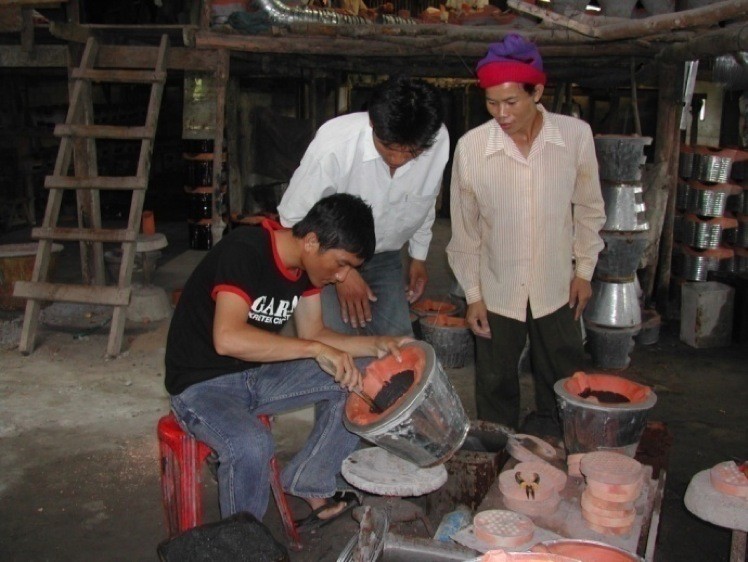To introduce improved stone technology and know-how to areas with wood fuel scarcity, resulting in better living conditions for the local population
 Most people in Laos rely on wood fuel as their main energy source for cooking and heating. In some areas wood fuel is scarce and people spend a lot of their time and money to meet their daily cooking and heating energy needs. One of the regions with an acute wood fuel shortage is the Xiengkhuang province and, in particular, the Paek District. The reasons for the wood fuel shortage and the resultant high prices for firewood are twofold. On the one hand, the shortage is due to natural circumstances such as low soil quality and water shortages during the dry season. This is compounded by external causes, such as the heavy bombing of the region during the liberation war in the sixties and seventies, which resulted in a lack of available forest resources.
In order to improve the energy situation and protect the environment in this region, the Technology Research Institute (TRI), in close cooperation with the Provincial Science, Technology and Environment Office (STEO), initiated this project. The aim was to introduce more efficient wood stoves to the local communities. The stoves that were traditionally used were very inefficient, ranging from traditional three stone stoves, over iron tripods, to stoves that could burn wood fuel as well as charcoal.
Most people in Laos rely on wood fuel as their main energy source for cooking and heating. In some areas wood fuel is scarce and people spend a lot of their time and money to meet their daily cooking and heating energy needs. One of the regions with an acute wood fuel shortage is the Xiengkhuang province and, in particular, the Paek District. The reasons for the wood fuel shortage and the resultant high prices for firewood are twofold. On the one hand, the shortage is due to natural circumstances such as low soil quality and water shortages during the dry season. This is compounded by external causes, such as the heavy bombing of the region during the liberation war in the sixties and seventies, which resulted in a lack of available forest resources.
In order to improve the energy situation and protect the environment in this region, the Technology Research Institute (TRI), in close cooperation with the Provincial Science, Technology and Environment Office (STEO), initiated this project. The aim was to introduce more efficient wood stoves to the local communities. The stoves that were traditionally used were very inefficient, ranging from traditional three stone stoves, over iron tripods, to stoves that could burn wood fuel as well as charcoal.
 The project consisted of three phases. The objective of the first phase was to gain acceptance of the improved stoves and to establish a baseline to measure the performance of the new stoves. 60 stoves were imported from Thailand and Vietnam and distributed to local women's unions in three target villages. The intention was to collect information about how appropriate the stoves were for the local conditions and to measure the fuel consumption of the improved stoves compared to the other stoves in use in local households. The second phase saw the introduction of local production of the improved stoves. During the course of two workshops, nine artisans, most of whom were traditional stove producers, were trained in all the processes of improved stove production. The participants were equipped with standardised tools to produce the improved stoves. At the same time, a promotion campaign was initiated to target potential users. In the final stage of the project the results of the improved cooking and heating stove project were published to make provincial and national authorities aware of the benefits of improved stove use. Training and information material was also produced in order to promote the introduction of improved stoves.
The project consisted of three phases. The objective of the first phase was to gain acceptance of the improved stoves and to establish a baseline to measure the performance of the new stoves. 60 stoves were imported from Thailand and Vietnam and distributed to local women's unions in three target villages. The intention was to collect information about how appropriate the stoves were for the local conditions and to measure the fuel consumption of the improved stoves compared to the other stoves in use in local households. The second phase saw the introduction of local production of the improved stoves. During the course of two workshops, nine artisans, most of whom were traditional stove producers, were trained in all the processes of improved stove production. The participants were equipped with standardised tools to produce the improved stoves. At the same time, a promotion campaign was initiated to target potential users. In the final stage of the project the results of the improved cooking and heating stove project were published to make provincial and national authorities aware of the benefits of improved stove use. Training and information material was also produced in order to promote the introduction of improved stoves.
Technology, Operations and Maintenance
 The improved cooking stove design chosen for the project was not the most efficient stove design, but was the most suitable for the local conditions. It has a wide opening so that it is possible to use large pieces of wood. The users of the imported stoves during the test phase were satisfied with the stove performance in terms of smoke reduction, shorter cooking times and, in particular, lower firewood consumption.
After the successful introduction phase, stove producers were trained to manufacture improved wood stoves locally. By the end of the project, two of these producers had already started manufacturing the improved stoves alongside the traditional stoves. To ensure a future market and the long-term success of the technology, quality control in form of user feedback was an integral part of the project. The users of the first locally produced stoves criticised the fact that the stoves cracked after a few weeks of use. To overcome this problem the ratio of clay to black ash was changed from 1:2 to 1:25.
The improved cooking stove design chosen for the project was not the most efficient stove design, but was the most suitable for the local conditions. It has a wide opening so that it is possible to use large pieces of wood. The users of the imported stoves during the test phase were satisfied with the stove performance in terms of smoke reduction, shorter cooking times and, in particular, lower firewood consumption.
After the successful introduction phase, stove producers were trained to manufacture improved wood stoves locally. By the end of the project, two of these producers had already started manufacturing the improved stoves alongside the traditional stoves. To ensure a future market and the long-term success of the technology, quality control in form of user feedback was an integral part of the project. The users of the first locally produced stoves criticised the fact that the stoves cracked after a few weeks of use. To overcome this problem the ratio of clay to black ash was changed from 1:2 to 1:25.
Financial Issues and Management
The firewood consumption of an average family in the project area was 6 - 18 m3 per year depending on the family size. The villagers were either buying firewood or collecting firewood themselves. For the families who had to purchase firewood, the cost amounted to between € 19 and € 115 per year. By switching to the improved stoves the firewood consumption, with its related cost in terms of both money and time, could be reduced by about 20% to 50%. The improved stoves cost around € 2.50 (28,000 kip/stove) to buy, which is 1.5 to 2 times higher than a traditional stove. This price includes delivery costs and profit for the retailer. In order to convince the retailers of the viability of selling the new stoves, the initial order of 220 stoves was paid for by the project fund. These stoves were placed in local shops and the retailers only had to pay for them once they had been sold. After this first order had been successfully sold, nine retailers recognised the market potential for the improved stoves and were then willing to purchase stock upfront.Environmental Issues
The reduction of firewood consumption has two positive impacts on the environment. There is less demand on existing wood resources and, also, a reduction in the harmful CO2 emissions that occur during the burning of firewood. As almost 3,000 improved stoves were in use by the end of the project period, this equates to annual CO2 emissions savings of around 4,500 t. These are not reductions of fossil fuel based CO2 emissions, but of inefficient biomass burning emissions.Social Issues
The local population benefits from the use of improved cooking and heating stoves in the form of reduced time and work spent on firewood collection. Families who currently purchase firewood also reduce their costs and can save the money for other needs. In addition, less firewood used also means less indoor air pollution, which benefits the health of the stove users. The project also provided technical training for local stakeholders, so that the improved stove technology can be manufactured locally. The knowledge, skills and value created through the project can provide benefits and offer income opportunities for manufacturers and retailers within the project region.Results & Impact
At the official end of the project in 2008, more than 2,850 improved wood stoves were in use within the project area. Two of the nine trained local artisans were already commercially producing improved stoves. In this way the project created employment and income opportunities in the region and, at the same time, users of the improved stoves save money and time because of their need for less firewood.Replicability
 Following the successful introduction of improved wood stoves in the project region, the market is expected to grow. This offers the opportunity to replicate the skill building activities throughout the region and beyond. In order to help develop the adoption of the improved stoves, promotional material in the form of two films and a training manual describing the improved stove production process was created in cooperation with the local partners. This promotional material could also be used in other rural regions of Laos to inform the population about the technology and to commercialise the improved wood stove technology. The project could also be replicated in other regions around the world that face wood fuel scarcity and similar social conditions, although the specific design of the stove would always have to be adapted to suit local conditions.
Following the successful introduction of improved wood stoves in the project region, the market is expected to grow. This offers the opportunity to replicate the skill building activities throughout the region and beyond. In order to help develop the adoption of the improved stoves, promotional material in the form of two films and a training manual describing the improved stove production process was created in cooperation with the local partners. This promotional material could also be used in other rural regions of Laos to inform the population about the technology and to commercialise the improved wood stove technology. The project could also be replicated in other regions around the world that face wood fuel scarcity and similar social conditions, although the specific design of the stove would always have to be adapted to suit local conditions.